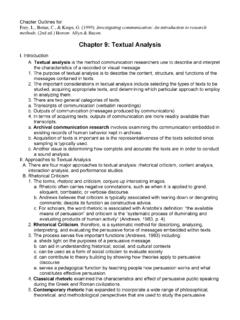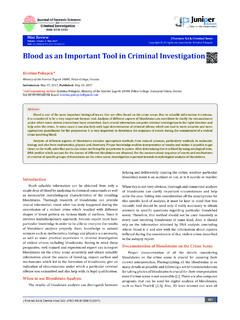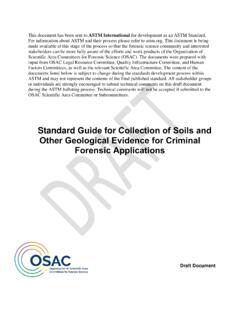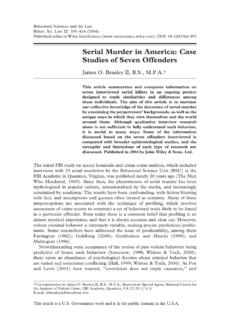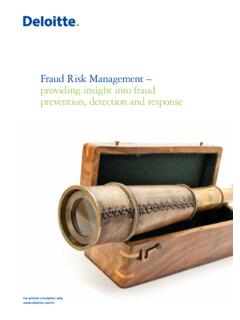Transcription of Forensic Toxicology in Death Investigation
1 CHAPTER 5 Forensic Toxicology in Death Investigation Eugene C. Dinovo, , and Robert H. Cravey Forensic Toxicology is a highly specialized area of Forensic science which requires exper-tise in analytical chemistry, pharmacology, biochemistry, and Forensic Investigation . The practicing Forensic toxicologist is concerned not only with the isolation and identification of drugs and other pOlsons from tissues, but also with the interpretation of his findings for the medical examiner, coroner, or other legal authority. In our modern drug-oriented society the need for the services of a toxicologist is clear. The benefits received from medication are so well publicized that society tends to minimize the dangers and pitfalls. The American people spend over $9 billion a year on drugs. In 1971, the public spent approximately $5% bil-lion on prescription drugs and about $3'12 bil-lion for over-the-counter medications (Arena 1974).
2 It has been estimated that there are as many deaths from drugs as from automobile accidents. During a I-year period at the Montreal General Hospital, for example, 25 percent of the deaths on the public medical service were the result of adverse drug reac-tions (Martin 1971). Estimates of deaths from adverse drug reactions in the United States range from 3,000 to 140,000 (Talley and Laventurier 1974). The cause of Death in drug cases may range from a clear and obvious overdose, often sub-stantiated by a suicide note, to a minor drug-related pathological process which, over an extended period, leads to a general decline in health. The latter situation is rarely recorded in mortality statistics. THE MULTIDISCIPLINARY TO DRUG Death Investigation About 20 percent of all deaths occur in circumstances that, under the laws of most 31 States, warrant an official Investigation by the coroner or medical examiner to determine the cause of Death .
3 The resolution of many legal questions depends on the official pronounce-ment of the cause of Death . The settlement of insurance claims often rests on the pro-nouncement of the Death investigator. Accu-racy in determining the cause of Death depends on the cooperation and free flow of informa-tion among all members of the medicolegal investigative team: the police homicide investigator, the medical examiner's investi-gator, the Forensic pathologist, the Forensic toxicologist, and the medical examiner. The homicide investigator is usually the first to view the scene and, if he is properly trained, it is he who maintains the scene undisturbed for the medical examiner whom he calls. The medical examiner's investigator is fre-quently the only member of the medical examiner's staff to actually view the scene and talk to witnesses.
4 He carries the main brunt of the Investigation . He must obtain all information possible from the first officer on the scene, arrange for photographs of the body and the scene to be taken, collect and preserve all evidence including medications and empty containers found at the scene, interview all witnesses as well as family and friends, and obtain a medical history from family and/or attending physician. Several excellent references are available, in addition to chapters 2, 6, and 9 in the present book, to aid the investigator and the medical examiner: Medicolegal Investigation of Death (Spitz and Fisher 1973), Homicide Investigation (Snyder 1967), Techniques of Crime Scene Investiga-tion (Svensson and Wendel 1972), and The Pathology of Homicide (Adelson 1974). The Forensic pathologist performs the gross autopsy, collects the proper specimens for analysis, and submits these specimens to the If you have issues viewing or accessing this file contact us at DINOVO AND eRA VEY toxicologist.
5 Although gross findings in drug-induced and drug-related deaths are often nonspecific, , visceral congestion and edema, discrete evidence suggesting poisoning by drugs has been documented (Svensson and Wendel 1972; Adelson 1974; Siegel, Helpern, and Ehrenreich 1966; Helpern and Rho 1966; Helpero 1972; Siegel 1972; Garriott and Sturner 1973; Citron et al. 1970; Hirsch 1972). The Forensic toxicologist is a crucial mem-ber of the tean1, and the objective laboratory evidence he gathers must be considered, eval-uated, and explained in the final assessment of the cause of Death . COLLECTION AND PRESERVATION OF SPECIMENS FOR ANAL VSIS The evidence and information obtained by the toxicologist is only as good as the quality of his specimens. The proper specimens must not only be obtained uncontaminated, but must also be preserved in their original con-dition for the toxicological analyses to be meaningful.
6 The human body is a dynamic organism even in Death , and metabolism, oxidation, and bactelial growth may con-taminate, modify, or destroy substances of interest so that they cannot be detected unless the specimens are properly preserved. The pathologist should confer with the toxicologist concerning the choice and preser-vation of specimens, especially in cases requir-ing special treatment or exotic chemical analyses. Tissues other than blood should be promptly frozen upon collection. As for the blood sample, the toxicologist may prefer that it be collected in a chemically clean or a sterile container and maintained under refrigeration to avoid hemolysis. Chemical preservation may interfere with some toxic-ological assays. It is recommended that samples of all tissues and fluids be ol)tained, placed in separate containers, and properly labeled at the time of autopsy regardless of the circum-stances of the particular case.
7 This procedure will help the toxicologist in his search for possible poisons throughout the body. It will also prevent disinterment of the cadaver, with concurrent toxicological problems caused by the embalming fluid and decomposition if, due to new findings or history obtained following autopsy, a seemingly clear and straightforward case suddenly becomes sus-pect. The specimen containers should be sealed with a coroner's or medical examiner's seal and appropriate arrangements made for delivery in order to maintain a valid chain of custody. A portion of each tissue must be saved by the toxicologist so that results of the analyses can be corroborated by another laboratory, should the occasion alise. The size of the tissue sample required for the toxicologist to do his work will often be dependent on the instrumental capability of his laboratory.
8 For example, if gas chroma-tography/mass spectrometry (GC/MS) with a computer data system is available, small quantities of each tissue may suffice. Con-versely, if the laboratory is operating on a small budget with little instrumentation, very large samples may be desirable. Fluids and Tissues Most Often Analyzed The tissues to be collected may be depend-ent upon the drug or other toxic substance suspected. In any case involving the accidental or intentional overdose of drugs, blood, gas-tlic contents, liver, bile, and urine (if available) should be considered minimal requirements for allalysis. Regardless of how well the on-scene Investigation is conducted, and ihe thoroughness of the autopsy, precisely what toxic compounds caused or contributed to Death is sheer speculation until the chemical analyses are complete.
9 Therefore, a large quantity of each tissue or fluid is always pre-ferable. If a storage problem exists, temporary arrangements can usually be worked out with commercial cold-storage firms to meet secu-rity requirements for a minimal cost. The choice of specimens and the quantity required do not pose apr _ulem for the major medical examiners' offices in the United States since these operations are contained in a central facility and the pathologist and toxicologist are able to confer on each case. In a significant number of coroners' offices, autopsies are conducted in various hospital morgues and mortuaries and the tissues trans-ported to laboratolies some distance away. It Forensic Toxicology IN Death Investigation 33 is often difficult if not impossible for the pathologist and toxicologist to confer on each case.
10 Table 1 is offer2d as a guide for those pathologists to insure that adequate speci-mens are collected regardless of the nature of the case and the instrumental capability of the laboratory. As Adelson has pointed out (1974), when one is not sure what tissue to save, the only safe approach is to save every-thing. Urine. Urine is a valuable fluid for the toxicologist since it enables him to perform simple screening procedures such as spot tests and immunochemical tests for drugs or drug classes, thus quickly informing him of their presence or absence in a certain concentra-tion. Moreover, urine as the final depository of kidney drug excretion in many cases con-centrates the dmg and metabolites to levels that are readily detectable. Drugs and metabo-lites may still be present in urine when they are no longer detectable in the blood.










